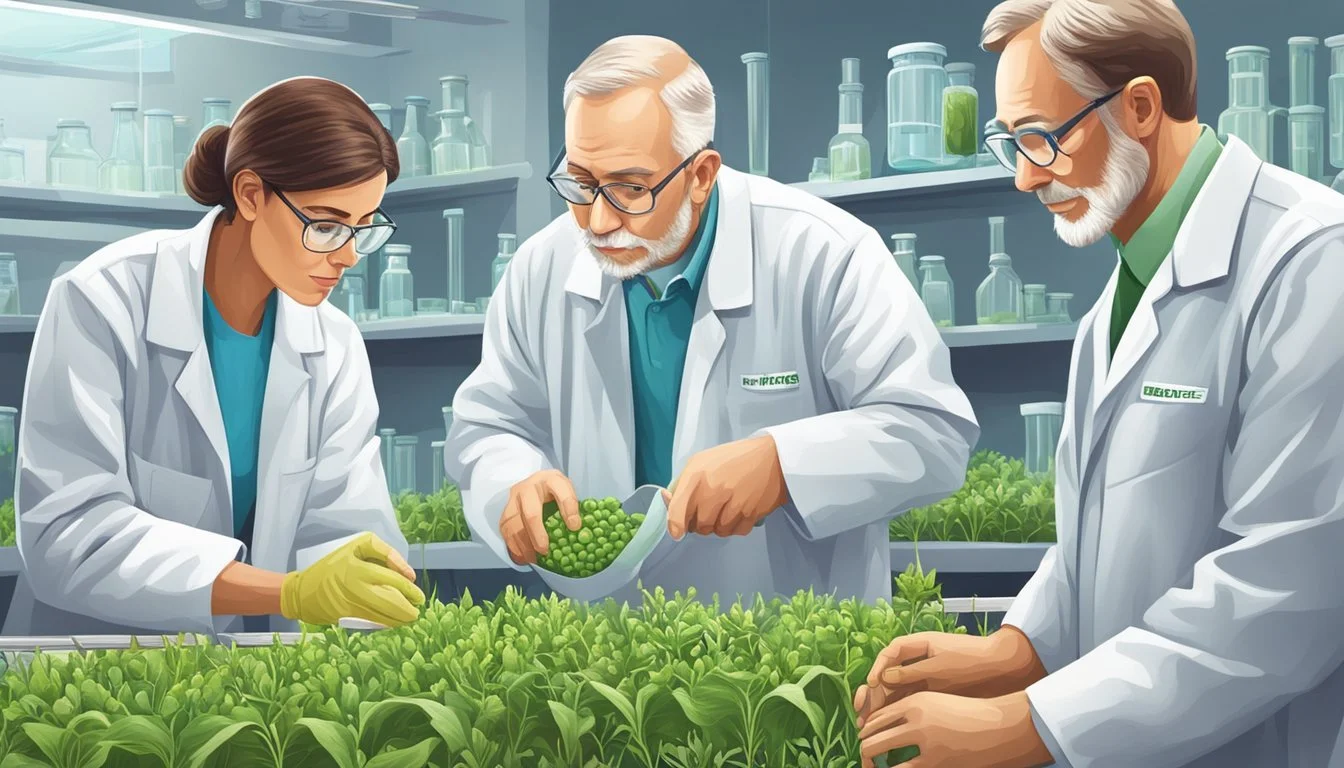10 Myths About GMOs
Separating Fact from Fiction
Genetically modified organisms, or GMOs, have been at the center of agricultural and food safety debates for decades. Despite the extensive scientific research and regulatory scrutiny they undergo, misconceptions about their nature and impact persist. Addressing these myths is crucial for understanding the role of GMOs in modern agriculture and their potential benefits.
Many people are concerned about the safety and environmental implications of GMOs, often fueled by widespread myths and misinformation. Clear and accurate information can help demystify GMOs and shed light on their real-world applications and effects.
1) GMO foods are unsafe for consumption
There is a widespread belief that GMO foods are unsafe for human consumption. This claim has been thoroughly investigated by a broad range of scientific studies.
Regulatory agencies worldwide, including the World Health Organization (WHO) and the Food and Drug Administration (FDA), have consistently affirmed the safety of GMO foods.
The National Academies of Science, Engineering, and Medicine published a comprehensive report in 2016 stating that GMOs pose no greater risk to human health than conventionally bred crops.
Numerous long-term studies have further supported these conclusions. Researchers have found no credible evidence linking GMOs to health problems or allergies.
In fact, GMOs can offer benefits, such as improved nutritional content and reduced exposure to harmful chemicals. For example, some GMO crops are engineered to be pest-resistant, reducing the need for chemical pesticides.
Overall, the scientific consensus is clear. GMOs are as safe to eat as their non-GMO counterparts.
2) GMOs cause allergies
Many people worry that GMOs introduce new allergens into the food supply. This concern stems from the idea that genetic modification might transfer proteins which could trigger allergies.
Scientific studies have scrutinized this issue. Researchers comparing genetically modified soybeans to non-GM soybeans found no increased allergenic potential. The technology used for creating GMOs does not inherently make foods more allergenic than conventional breeding.
Regulatory agencies require rigorous testing before GMOs hit the market. These evaluations ensure that GMOs do not contain new allergens or toxins. Extensive safety assessments are a crucial part of the approval process for GMO crops.
Some common allergens like milk, eggs, peanuts, and wheat cause most food allergies. These allergens are well-studied and are present in both GM and non-GM forms. Therefore, food allergies are not unique to GMOs and are primarily due to these traditional food products.
GMO labeling and food safety surveillance also help minimize health risks. By ensuring transparency, consumers can make informed choices about their food.
In conclusion, current scientific evidence and regulatory measures support that GMOs do not increase the risk of food allergies. The rigorous testing and evaluation process in place is designed to keep the food supply safe for consumers.
3) GMOs are not tested for safety
The claim that GMOs are not tested for safety is inaccurate. GMOs undergo extensive testing before they reach the market. Regulatory bodies such as the FDA, EPA, and USDA are involved in evaluating GMOs.
These tests include assessments of potential toxicity, allergenicity, and nutritional value. Scientists conduct both short-term and long-term studies to evaluate the safety of GMOs.
Thousands of studies have shown that GMOs are as safe to consume as their non-GMO counterparts. This body of evidence supports the conclusion that the rigorous testing processes are effective.
In addition to governmental oversight, independent researchers also study GMOs to verify safety. The scientific consensus is that GMOs do not pose a greater risk than traditional food products.
4) GMOs are banned in many countries
A multitude of countries have implemented bans on the cultivation and sale of genetically modified organisms (GMOs). In Africa, nations such as Algeria and Madagascar have established these prohibitions.
In Asia, several countries, including Turkey, Kyrgyzstan, Bhutan, and Saudi Arabia, have also opted for bans.
The Americas see a range of restrictions, with Belize, Ecuador, Peru, and Venezuela enacting similar measures. These bans reflect varied concerns over health and environmental impacts.
Despite these bans, the United States has no federal legislation prohibiting GMOs. This divergence illustrates differing global approaches to GMO regulation.
5) GMO crops harm the environment
There is a common belief that GMO crops are detrimental to the environment. For example, concerns about "outcrossing" exist, where genes from GMO crops transfer to wild plants and other crops. This gene transfer can potentially affect the natural ecosystem balance.
Pesticide use is another point of contention. While some argue that GMO crops reduce pesticide use, others worry about the development of pesticide-resistant pests. These concerns highlight the need for careful management and monitoring of GMO crop cultivation.
Impact on biodiversity is also frequently mentioned. Critics argue GMO crops may contribute to a reduction in other plant species. This happens when GMO traits such as pest resistance or herbicide tolerance dominate the agricultural landscape.
Despite these concerns, it's important to acknowledge the rigorous regulatory frameworks that oversee GMO development. These frameworks aim to ensure that GMO crops undergo thorough environmental impact assessments before approval for commercial use.
Lastly, studies have shown that GMO crops can reduce soil erosion and topsoil loss by enabling less tilling. Reduced tilling helps in maintaining soil structure and minimizing the runoff of fertilizers. This, in turn, helps protect surrounding ecosystems.
6) Organic foods are non-GMO
Organic foods are often believed to be non-GMO. This assumption stems from the strict standards that the organic label entails. According to U.S. regulations, for a product to be labeled organic, it must be produced without the use of genetic engineering.
Organic certification guidelines prohibit GMOs in the production of organic foods. This includes actions such as the seeds used and the feed given to organic livestock. Compliance with these guidelines is strictly monitored by certification bodies.
It's important to note that organic farmers employ various methods to ensure their crops remain non-GMO. These methods include physical barriers and buffer zones to prevent cross-contamination from neighboring genetically engineered crops.
Consumers seeking non-GMO products often opt for organic foods due to these stringent guidelines. However, non-GMO labels and certifications also exist independently of the organic designation.
In essence, while not all non-GMO foods are organic, all organic foods are required to be non-GMO by regulation. Organic labeling offers an extra layer of assurance for those wanting to avoid genetically modified organisms.
7) GMOs are responsible for farmer suicides
Claims have circulated that GMOs, particularly genetically modified cotton (Bt cotton), are to blame for a spate of farmer suicides in India. However, these assertions oversimplify a complex issue.
The actual data on farmer suicides indicate multiple contributing factors, such as economic hardships, crop failures, and indebtedness. Pinning the crisis solely on GMOs ignores these broader socio-economic challenges.
The annual rate of farmer suicides is 29 per 100,000, which is actually lower than the rate among non-farmers, at 35 per 100,000. Misattribution to GMOs can distract from addressing root causes like lack of adequate support systems and financial instability.
Assertions directly linking Monsanto's Bt cotton to 84% of suicides lack substantiated evidence. Peer-reviewed studies suggest that while some farmers experience difficulties, many have benefited from higher yields and reduced pesticide use.
Blaming GMOs alone for this tragedy fails to account for various external pressures impacting farmers. Addressing their plight requires a holistic approach, considering multiple contributing factors rather than isolating one cause.
8) GMO labels indicate a product is unhealthy
GMO labels often lead consumers to believe that such products are inherently unhealthy. This perception is not supported by scientific evidence. Numerous studies have shown that genetically modified organisms (GMOs) are as safe to eat as their non-GMO counterparts.
The presence of a GMO label typically means the product contains ingredients derived from genetically modified crops. These labels don't indicate nutritional quality or health risks. They simply inform the consumer about the nature of the ingredients.
The scientific community largely agrees that GMOs pose no greater health risks than conventional foods. Regulatory agencies around the world, including the FDA and European Food Safety Authority, have reviewed and approved GMOs for human consumption. They use rigorous testing to ensure safety.
Misinterpretations of GMO labels can lead to unnecessary fear and confusion among consumers. The main intention behind these labels is to provide transparency, not to suggest any health implications. For people concerned about food safety, understanding the extensive testing and approval process for GMOs can offer reassurance.
9) GMOs cause cancer
There is no scientific evidence that genetically modified organisms (GMOs) cause cancer in humans. Research conducted on the safety of GMOs shows that these foods are no more likely to cause cancer than conventional foods.
In the US, where GM foods are widely consumed, there has not been an increase in cancer cases attributed to these foods.
Animal studies have occasionally suggested possible links between GMOs and cancer, but these studies are not widely accepted due to methodological flaws. Regulatory bodies like the FDA and EFSA evaluate GM foods for safety before they reach the market.
Most scientific studies conclude that GMOs do not pose a higher risk of cancer compared to non-GMOs. Claims linking GMOs to cancer often stem from public misconceptions and a lack of understanding about genetic modification.
While ongoing research ensures continued monitoring, current evidence supports the safety of GM foods concerning cancer risk. As a result, consumers can feel confident in the safety of GM foods with respect to cancer.
10) GMOs are unnatural and therefore bad
The myth that GMOs are unnatural and therefore bad is widespread. The concept of genetic modification is often misunderstood. Humans have been altering the genetics of plants and animals for thousands of years through selective breeding.
Genetic engineering is an extension of this process. It uses modern technology to achieve changes more precisely. Bacteria and viruses have been transferring genes between species naturally for millions of years.
Claiming GMOs are unnatural dismisses the long history of plant and animal modification. Crops like wheat and corn are products of human intervention.
The idea that something "unnatural" is inherently bad is also flawed. Modern medicine, for example, is highly unnatural but has saved countless lives. Using the same logic, GMOs can offer significant benefits like increased nutritional content and pest resistance.
In conclusion, GMOs continue the ancient human practice of enhancing crops. They are not inherently bad simply because they are engineered. This misconception ignores the complex history of genetic modification and the potential benefits that GMOs can provide.
Understanding GMOs
Genetically Modified Organisms (GMOs) are organisms whose genetic material has been altered using genetic engineering techniques. Their development dates back to centuries of human practices in agriculture.
What Are GMOs?
GMOs are created by making specific changes to the DNA of plants or animals. These changes aim to introduce beneficial traits such as pest resistance, improved nutritional content, or increased yield.
The process involves identifying a desired trait from one organism and implanting that gene into another organism.
Key Points:
GMOs are not inherently unnatural; traditional breeding practices have been modifying genetics for millennia.
Techniques used in genetic engineering include gene splicing and CRISPR.
History of GMO Development
The concept of modifying organisms is ancient, with humans selectively breeding plants and animals for thousands of years.
The modern era of GMOs began in the 1970s with the development of recombinant DNA technology. The first GM crop, the Flavr Savr tomato, was commercialized in the early 1990s.
Important Milestones:
1973: Creation of recombinant DNA.
1994: Approval of the Flavr Savr tomato by the FDA.
2000s-Present: Widespread adoption of GM crops like soybeans, corn, and cotton.
This history underscores that genetic modification is a continuation of ancient agricultural techniques, now enhanced by modern science.
Common Myths About GMOs
Misconceptions about GMOs persist despite extensive scientific research. This section addresses two prevalent myths, focusing on their veracity and implications.
Myth: GMOs Are Unhealthy
A widespread belief is that consuming GMOs is detrimental to human health. In reality, multiple scientific organizations, including the World Health Organization and the American Medical Association, have stated that GMOs currently approved for market are as safe to eat as their non-GMO counterparts.
Many studies have thoroughly evaluated GMOs for potential health risks. These studies include toxicological, allergenicity, and nutritional assessments. The results consistently demonstrate no significant difference in health risks between GMO and non-GMO foods.
Opponents often cite concerns about allergies and long-term effects. However, every GMO undergoes rigorous testing before approval, ensuring that it does not pose an allergenic threat and has no adverse health effects.
Myth: GMOs Harm The Environment
Many believe GMOs negatively impact the environment by contributing to biodiversity loss and pesticide overuse. Scientific research, however, indicates that GM crops can actually benefit the environment when managed correctly.
For example, Bt crops produce a protein that is toxic to specific insect pests but harmless to humans and most other organisms. This reduces the need for chemical insecticides, which can harm non-target species like pollinators and beneficial insects.
Despite the environmental benefits, there are valid concerns about issues like herbicide-resistant weeds. These challenges require integrated pest management practices and ongoing research to mitigate potential negative impacts on the ecosystem.





